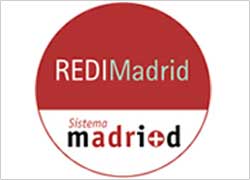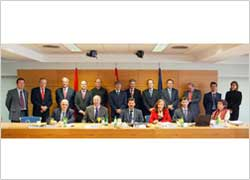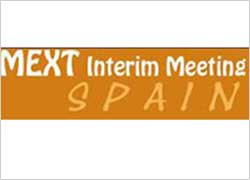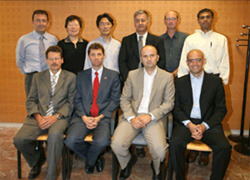IMDEA Networks

Archivos: Events
Corridor-based routing using opportunistic forwarding in OFDMA multi-hop networks
In multi-hop networks, conventional unipath routing approaches force the data transmission to follow a fixed sequence of nodes. In this talk, we widen this path to create a corridor of forwarding nodes. Within this corridor, data can be split and joined at different nodes as the data travels through the corridor towards the destination node. To split data, decode-and forward OFDMA is used since with OFDMA, one can exploit the benefits of opportunistically allocating different subcarriers to different nodes according to their channel conditions. To avoid interference, each subcarrier is only allocated once per hop. For the presented scheme, the problem of optimizing the network throughput by means of resource and power allocation is formulated and two suboptimal algorithms are proposed to solve this problem with feasible effort. Simulations show that in multi-hop networks corridor-based routing using opportunistic forwarding outperforms conventional unipath routing approaches in terms of achievable throughput.
Seguir leyendo arrow_right_altLow-Complexity Visible Light Networking with LED-to-LED Communication
Visible Light Communication (VLC) is an emerging technology in which Light Emitting Diodes (LEDs) transport information wirelessly, using the visible light spectrum. While most of the research on VLC has focused on wideband white LEDs used in ambient illumination, narrowband and colored LEDs have received little attention. Short-range free-space optical communication based on narrowband LEDs as visible light transmitters and receivers enable a variety of applications, a scenario we refer as LED-to-LED communication. In this work, we introduce the communication and networking protocols of LED-to-LED communication. Our work addresses fundamental challenges such as efficient collision detection medium access protocol and elimination of light flicker. We build a prototype and demonstrate bi-directional data exchange in a network of up to four LEDs. We further study the trade-offs in the system design and measure the achievable bit-rate and transmission distances
Seguir leyendo arrow_right_altThe Next Generation Wireless Sensor Network Challenges for an Emergency Preparedness and Response Class of Applications: A Necessary Public Safety and Security
Wireless sensor network and wireless multimedia network technologies combined with interactive 3D virtual visualization can converge into really interesting and functional applications such as detailed real-time monitoring of environments, emergency response and preparedness, distributed collaborative training, and remote walkthroughs, just to name a few examples. With the recent advances in wireless communication, and the proliferation of portable computer and micro-sensor devices, we are witnessing a growing interest in using wireless multimedia sensor networks and collaborative virtual environment technologies for safety and security class of applications.
Seguir leyendo arrow_right_altJornadas REDIMadrid 2007 – El Futuro de la Investigación en Red
El objetivo de estas jornadas es realizar una puesta en común sobre la importancia del soporte de las tecnologías de redes telemáticas en general, y de REDI Madrid en particular, para el desarrollo de una actividad de investigación puntera a nivel mundial. El soporte colaborativo de la actividad de grupos de investigación distribuidos, los entornos GRID, la supercomputación distribuida, las bases de datos científicas son ejemplos de aplicación en casi cualquier campo de investigación científica.
Seguir leyendo arrow_right_altTowards a Next Generation Internet Architecture
The international networking research community has begun to focus on ideas for a next generation Internet architecture. Before developing a next generation architecture, however, it seems appropriate to understand what exactly the problems are with the current Internet architecture. There seems to be widespread agreement that mobility and security are the primary problems stressing the current Internet, but exactly what the problems with mobility and security are, and in particular, whether the problems are architectural in nature, is under dispute. In this lecture series, we examined the mobility and security with the intention of understanding the current architecture and what might be done for a next generation architecture.
Seguir leyendo arrow_right_altSilver-lining: a firsthand vision of launching a technological start-up
Vishal Misra together with Dan Rubinstein launched at the beginning of 2011 the company Silver Lining. This company is a very ambitious tech start-up arising from two professors of Columbia University, and has already attracted a lot of interest and a substantial amount of funding from investors. Silver Lining is developing a very advanced product in the area of content distribution networks that is expected to have high impact. Vishal Misra, co-founder and its current CEO, will give a first-hand account on the development of this interesting initiative.
Seguir leyendo arrow_right_altIMDEA Networks Board of Trustees
Please note: Attendance restricted to members only
The meeting will be conducted in English
Seguir leyendo arrow_right_altVIII Feria Madrid es Ciencia
La Feria Madrid por la Ciencia (The Forum for Science) is a key part of the Programa de Ciencia y Sociedad (Science and Society Program) that the Regional Government of Madrid launched in 2000, through the Dirección General de Universidades e Investigación (Directorate-General of Universities and Research). This Program seeks not only to promote dialogue between citizens and scientists, but also to increase the public’s participation in science.
Seguir leyendo arrow_right_altMext Interim Meeting 2007: Focusing on nemo global development
Mext Interim Meeting 2007: Focusing on nemo global development
The conference will be conducted in English
Seguir leyendo arrow_right_altEl Consejo Científico internacional celebra con éxito su reunión inaugural
El pasado 11 de Julio la Fundación IMDEA Networks celebró la reunión anual inaugural de su Consejo Científico en Madrid. La reunión marcó un punto importante en el establecimiento de la fundación de la investigación. Este prestigioso Consejo se compone de once investigadores de los más importantes del Mundo en la tecnología de redes.
El Consejo fue presentado a dignatarios, incluyendo representantes senior de la Comunidad de Madrid, quienes crearon y fundaron la iniciativa IMDEA. Tras aceptar formalmente sus cargos como Miembros del Consejo, estos eminentes expertos consideraron varios aspectos de la estrategia científica de la Fundación, lo que ayudará a orientar la dirección de investigación que se debería perseguir en los próximos años.
Seguir leyendo arrow_right_alt











Comentarios recientes